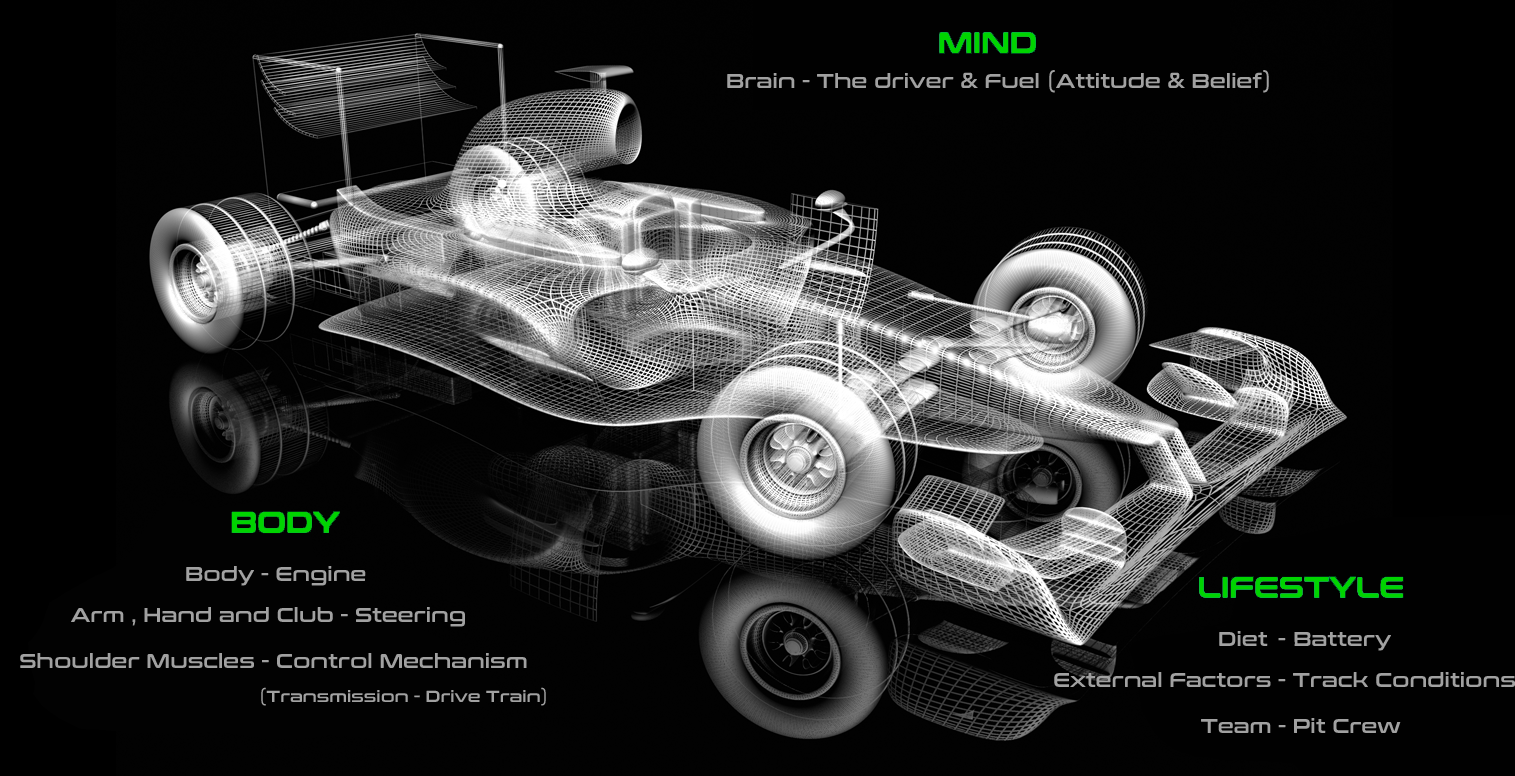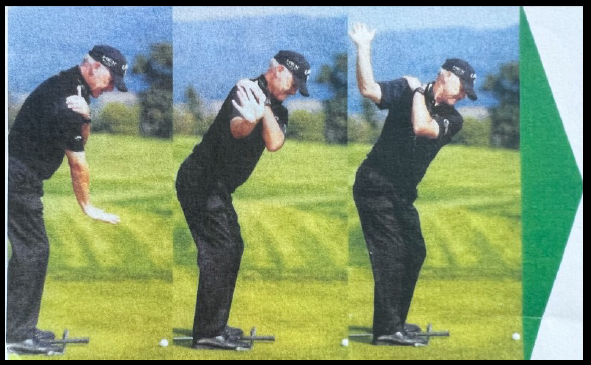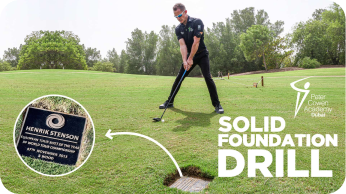CODE2 Tutorial
CODE 2 - GOLF UNCOMPLICATED: IT'S JUST A MOVEMENT
Building A Successful Golf Swing Is Like Building A Race Car: You Need The Perfect Engine, The Best Driver, And The Best Fuel. 99.9% Of Golfers Will Improve By Understanding The Correct Mind-Body Connection Which Is Key To Consistent Movement.


Do you change your swing thoughts constantly?
Or maybe a friend of yours gave you what you think is a life changing tip?
To achieve consistency in golf, one must understand and master the essential movements. This involves training the brain to send the correct stimuli to the muscle structure, ensuring the movement can be accurately repeated each time.
Building a successful golf swing is like building a race car: Which to win races you would need A perfect engine, the best driver, the best fuel and the best team delivering the right information. 99.9% of golfers will improve by understanding the correct MIND BODY connection that creates consistent movement. Code 2 explains the component parts that need to be practiced. After all Golf Is only A sequence of move-ments, controlled by your control centre (Brain) and muscle structure (Body).
The essence of golf is creating and maintaining a repeatable movement. Many golfers struggle with consistency because their brains are con-fused by varying movement patterns. We call it the here today gone tomorrow approach. This is due to the brain being confused from differ-ent movement patterns. By focusing on a single, effective movement and sticking to it, you can achieve greater consistency and improve your game.
To master The Spiral Code 2, it's crucial to understand each component and how they function together. This understanding will help you develop a structured practice routine. What component parts do we need?

Key Takeaways:
- Knowledge of Components: Learn the essential parts of the golf swing.
- Mind-Body Connection: Understand how your brain and muscles work together.
- Structured Practice: Implement a routine stick to a natural repeatable movement based on our proven codes.
- Reduced Manipulations: Rely on solid foundations to mini-mize the need for constant adjustments.
- Professional Guidance: Work with Peter Cowen accredited coaches for personalized advice.
Have You Ever wondered why it doesn't stick?
Explore the Structured Approach. Delve deeper into each component of our comprehensive methodology. Click above to discover detailed insights on each aspect.
Warning - This Section is Only for Golf anoraks
Have You Ever wondered why it doesn't stick?
There is a chance that a quick fix will work but long term improvement and consistency comes from under-standing the movement and practicing the movement. There is a reason it doesn't stick.
- Understanding the Movement: Whether it's a physical skill, a habit, or a cognitive process, understanding the mechanics and principles behind it is crucial. This understanding provides the foundation for effective practice and improvement.
- Consistent Practice: Regular, deliberate practice helps to reinforce learning and build muscle memory or cognitive patterns. This repetition is essential for ingraining the new skill or behaviour.
- Adversity and Hard Work: Overcoming challenges and persevering through difficulties is often where real growth happens. Adversity can test our commitment and resilience, making the eventual success more meaningful.
- Attitude and Mindset: A positive and growth-oriented attitude is a vital component of learning and improvement. Believing in one's ability to learn and improve, staying motivated, and maintaining a constructive outlook can significantly impact progress and persis-tence. This is why you will find Attitude and Belief form the top to our pyramid of learning.
These elements together create a comprehensive approach to achieving long-term success and mastery in any area.
DON’T WAIT TO FIND IT BUILD IT
(Peter Cowen)
BODY - The Engine
When I talk to my players about the inner workings of the golf swing, I often come back to a simple yet effective analogy of a car. Imagine you have a car with a stunning engine that purrs along without ever missing a beat, and the steering mechanism operates all four wheels perfectly. The reaction is precise, and the components work well independently. But if the car handles terribly, zigzagging unpredictably, the issue isn't with the driver or the fuel. The problem lies in the transmission or the linkage. This component is crucial for translating the engine's power and the steering's precision into smooth, controlled movement.
In the context of a golf swing, you may have a good body action (the engine) and excellent arm, hand, and club action (the steering mecha-nism). Individually, these components are great. However, when you try to synchronize them to create a fluid swing, the movement can be-come erratic and unpredictable. Here, the linkage between these components is the problem—a conclusion I have reached through years of coaching and observation. The linkage in this analogy is the shoulder action, or what I refer to as the drive-train (transmission).
The reason for this focus on the shoulders is simple: in golf, the shoulders represent the critical point of connection between your body action (involving the rotation of larger muscles) and the precise movements of the arms, hands, and club. To my mind, the way we link these two components together is one of the most overlooked aspects of coaching. This principle underpins our philosophy: load to unload, equal and opposite reactions, action and reaction, input and output.
To optimize the efficiency of energy transfer between your body and the club, you must understand how to first 'LOAD' the shoulders during the backswing to correctly unload them in the downswing. As you quickly discover when you stand up and wave your arms about, the shoul-der is essentially a universal socket—it moves in all directions. This is a wonderful characteristic of human anatomy but a potential problem for the golfer who allows their shoulders to become hyper-mobile during the swing. Once the shoulders become uncontrollable, the swing plane and path tend to become erratic, creating the need for compensations that detract from consistency and power.
Let's delve into the mechanics and importance of proper shoulder action in greater detail:
Shoulder Loading in the Backswing:- During the backswing, the shoulders play a pivotal role in setting up the power potential for the downswing. Proper loading involves a controlled rotation where the lead shoulder moves under the chin, creating a coil that stores energy. This coiling action should be smooth and consistent, avoiding excessive lateral movement or lifting from the body action.
- The concept of maintaining a connection between the arms and the body is crucial. The shoulders must guide the arms while remaining connected to the torso, ensuring that the movements are unified. This connection prevents the arms from becoming independent, which can lead to a loss of power and accuracy. We call this matching movements.
- The transition from backswing to downswing is a common struggle for many golfers. During this phase, the shoulders must move from a loaded position to an active role early in the downswing. This action guides the arms down and around, utilizing the counter coil from the body movement. The key is to position the club correctly for the intended shot. This transition should be seamless, using natural forces to create momentum, with the body supporting the arm, hand, and club action through impact.
- The plane and path of the swing are significantly influenced by shoulder action. By keeping the shoulders on a consistent plane, you en-sure that the club follows a predictable path. This consistency is vital for solid ball striking and accuracy. Uncontrolled shoulder movement can cause deviations in the swing plane, leading to errant shots.
- The shoulders are also instrumental in generating clubhead speed. Proper sequencing, where the shoulders lead the downswing followed by the arms and hands, creates a whip-like effect that maximizes speed from delivery to post impact. This efficient transfer of energy re-sults in the correct body, shaft a dn clubface pressure on the golf ball. For compressed longer controlled shots.
- Hyper-mobility in the shoulders can lead to instability in the swing. It is essential to train the shoulder muscles to remain stable and con-trolled throughout the swing. This can be achieved through simple Signature Peter Cowen Accelerated Learning Drill that focus on strengthening and stabilizing the shoulder girdle.
In conclusion, understanding and mastering shoulder action is essential for a consistent and powerful golf swing. By focusing on how to load and unload the shoulders correctly, you can create a more efficient and effective swing, leading to better performance on the course. The shoulders, acting as the transmission, ensure that the power generated by the body and the precision of the arms are translated into a smooth, controlled, and powerful swing.

3 pictures showing pete with the left hand on the right shoulder and using the right elbow to fold and fingers at 45 degrees or on plane.
Hold it and feel it! Learning to “Load” the shoulders correctly is the critical first step in the process of building a better and more efficient golf swing.. FEELING THE PRESSURE IN THE SHOUDLERS JC TALK ABOUT LOAD WHAT WE MEAN BY LOADING THE SHOUDLERS
Key Takeaways:
Engine (Body):- Load Power: The body loads the power and helps to position the club on the backswing. The body loads power up in a spiral movement on the backswing.
- Positioning the Club: The body changes direction to position the club for the correct delivery. The body spirals into the ground to create ground force in a change of direction.
- Stabilize Impact: The body continues to turn (not pull) to stabilize the impact.
- Maintaining Balance: The body helps to slow the club down and maintain balance after the swing.
- Grip Stability: The hands hold onto the club to stabilize the face through equal and opposite pressure.
- Wrist Cock and Hinge: The wrist cock and hinge help achieve neutral positions, with elbow fold and shoulder load aiding stability.
- Shoulder Movement: Stable shoulders allow the shoulder muscles to move the arms effectively.
- Repetitive Movements: Loading and unloading the shoulder muscles should be repetitive and unconscious.
- Control Element: The shoulder muscles control and enhance the club's path.
- Lead Arm Movement: The lead arm's movement is crucial for achieving the correct path.
MIND - The Brain as Driver and Fuel
In my pyramid of learning, at the top, you'll find Attitude and Belief. Without the correct attitude, success remains elusive. To cultivate the right attitude, I emphasize the three R’s: Respect yourself, Respect those around you, and take Responsibility for all actions and decisions. This foundation is crucial. From here, it’s your hunger and mental strength that propel you forward, which is why Belief is paramount at the top. Many golfers possess the physical skills, but few have the mental fortitude to excel under pressure.
Attitude: The cornerstone of success is the correct attitude. With Respect and Responsibility, you create a stable base upon which everything else is built. Respect fosters a positive environment, while responsibility ensures accountability and growth.
Belief: Belief is the fuel for your mental engine. Without Belief, skills remain untapped potential. Confidence born from belief transforms prac-tice into performance.
Hunger and Mental Strength : Your drive, or hunger, coupled with mental strength, keeps you focused and resilient. The greatest athletes dis-tinguish themselves by their mental tenacity.
To convert Attitude into tangible results, we apply the three D’s: Desire, Dedication, and Discipline.
- Desire: Have a burning desire to understand what you need to achieve. Identify the movements and skills that need mastery. This desire pushes you to outwork everyone else.
- Dedication: Stay focused and committed, even when the going gets tough. Dedication involves grinding it out during those moments of doubt and fatigue. This is where true growth happens.
- Discipline: Perhaps the hardest quality to master, discipline is the work done behind the scenes. It’s the relentless practice and preparation that sets the stage for performance. The time on the track, or in competition, is the fun part, but it’s the unseen effort that makes it possible.
Creating Habits: Repetition builds confidence and belief. Every practice session, every moment of focus, strengthens your mental assurance. This process is akin to an iceberg: the tip is visible success, but the bulk of the iceberg—your unseen efforts and discipline—supports everything.
Building Mental Assurance and Confidence: Working through these steps increases your Belief through repetition. This belief is both the driv-er and fuel of mental assurance and confidence. It transforms potential into consistent performance, ensuring that when it matters most, you are mentally prepared to excel.
To achieve perfection in practice, all lifestyle factors must be aligned. When your body is well-nourished, your mind is calm, and your support team is in place, you can focus entirely on perfecting your skills. This holistic approach ensures that every practice session is as effective as possible, paving the way for excellence in performance.
In conclusion, lifestyle is the foundation upon which high performance is built. By prioritizing nutrition, rest, mental health, and having the right support team, an athlete can maximize their potential and achieve consistent success.
Lifestyle - The Final Components
The final component of building a high-performance movement is Lifestyle. Just as a race car needs a fully charged battery and a well-prepared team (pit crew), an athlete needs a supportive environment and proper preparation to perform at their best. Lifestyle encompasses everything from nutrition to the quality of the support team, and it directly impacts performance.
Why Lifestyle Affects Performance
- Nutrition (Battery): Eating well is fundamental. The body requires the right fuel to perform optimally. A balanced diet rich in essential nutrients supports energy levels, recovery, and overall health. Poor nutrition can lead to fatigue, slower recovery, and increased injury risk.
- Support Team (Pit Crew): Surrounding yourself with the right team is crucial. This includes coaches, trainers, nutritionists, and mental health professionals. Each member of the team plays a specific role in enhancing performance, providing expertise, and offering emotional and psychological support.
- Rest and Recovery: Adequate rest and recovery are as important as training. Overtraining can lead to burnout and injuries, while proper rest allows the body to repair and strengthen. A good lifestyle includes structured rest periods and recovery strategies like sleep, massage, ice baths, and active recovery sessions.
- Ice Baths: Ice baths are a common recovery method used to reduce muscle soreness and inflammation. The cold temperature constricts blood vessels, which helps flush out waste products like lactic acid from the muscles. Upon exiting the ice bath, blood flow is enhanced, bring-ing oxygen and nutrients to aid in muscle repair.
- Trigger Point Therapy: Trigger point therapy involves applying pressure to specific points in the muscles that are tight or painful. This technique helps to release muscle knots, improve blood circulation, and reduce pain. Incorporating trigger point therapy into a recovery rou-tine can enhance flexibility, decrease muscle stiffness, and accelerate recovery.
- Mental Health: Mental well-being is a key component of performance. Stress management, mindfulness practices, and having a positive mindset contribute to better focus, resilience, and overall mental strength.
To achieve perfection in practice, all lifestyle factors must be aligned. When your body is well-nourished, your mind is calm, and your support team is in place, you can focus entirely on perfecting your skills. This holistic approach ensures that every practice session is as effective as possible, paving the way for excellence in performance.
In conclusion, lifestyle is the foundation upon which high performance is built. By prioritizing nutrition, rest, mental health, and having the right support team, an athlete can maximize their potential and achieve consistent success.
The Race may be a Game, but preparation is what sets the stage for victory
Master Trained Professional
Jonathan Craddock
#CODE3
Maximize Your Potential: Who Will Benefit from Our Platform?
CODE3 Explains how every golfer of any age can benefit from structured development but one must understand the road is a constant journey that needs navigating. “The Road To Success Is Always Under Construction, Peter Cowen.

Pro + Subscription



Pro + Subscription


Wide Stance
this explains the benefits behind the Peter Cowen wide stance.

5 minutes

8 Videos

Pro + Subscription

